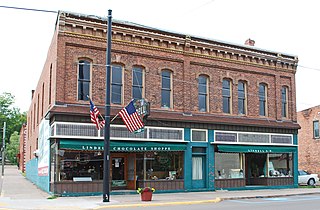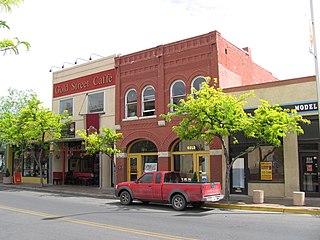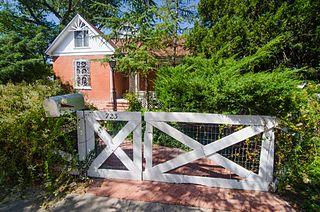
The First National Bank Building is a historic building in downtown Albuquerque, New Mexico, and the former headquarters of the First National Bank of Albuquerque. The nine-story building was completed in 1923 and was considered the city's first skyscraper with an overall height of 141 feet (43 m). It remained the tallest building in the city until 1954, when it was surpassed by the Simms Building.

The Lake Linden Historic District is located in the village of Lake Linden in Houghton County, Michigan.

The Joseph Bosch Building is a commercial structure located at 302 Calumet Avenue in the Lake Linden Historic District in Lake Linden, Michigan. It is also known as the Lindell Chocolate Shoppe. It was listed on the National Register of Historic Places and designated a Michigan State Historic Site in 1982.

Hodgin Hall, previously known at various times as the University Building, Main Building, or Administration Building, is a historic building on the University of New Mexico campus in Albuquerque, New Mexico. Completed in 1892, it was the first building constructed on the UNM campus and the university's only building for almost a decade. The building was originally designed by Jesse Wheelock in the Richardsonian Romanesque style, but structural problems with the building's roof gave university president William Tight the opportunity to have it remodeled in his preferred Pueblo Revival style in 1908.

The James Emery House, also known as Linwood Cottage, is a historic house on Main Street in Bucksport, Maine. An architecturally eclectic mix of Greek Revival, Gothic Revival, and Italianate styling, the house was built c. 1855 on a site overlooking the Penobscot River. It was listed on the National Register of Historic Places in 1974 for its architectural significance.

The Hope Building is a historic commercial building in Albuquerque, New Mexico. Built in 1894, it is one of the only surviving 19th century buildings in Downtown Albuquerque. It was added to the New Mexico State Register of Cultural Properties and the National Register of Historic Places in 1980.

The Twin City Historic District in Twin City in Emanuel County, Georgia is a historic district which was listed on the National Register of Historic Places in 2014.

The Newlander Apartments are a historic apartment building in Albuquerque, New Mexico. Originally built as a single-family house in 1901 and expanded via a number of additions, it is notable as a well-preserved example of the small boarding houses and apartment buildings that housed much of Albuquerque's working-class population in the early 20th century. The building is listed in the New Mexico State Register of Cultural Properties and the National Register of Historic Places.

The Charles W. Lewis Building is a historic building in the Barelas neighborhood of Albuquerque, New Mexico. It is listed on the New Mexico State Register of Cultural Properties and the National Register of Historic Places. It was built around 1882 by Charles W. Lewis (1844–1901), a native of Peralta, New Mexico who came to Albuquerque in 1873. Lewis was one of many Albuquerque residents to get involved in land speculation as the Atchison, Topeka and Santa Fe Railway approached the town in the late 1870s. Once the railroad arrived, Lewis was able to subdivide a valuable piece of land near the tracks and used one of the lots for the building described here, which was probably built as rental housing. In 1915 it was reportedly being operated as a saloon.

The Weinmann Block is a commercial building located at 219-223 East Washington Street in Ann Arbor, Michigan. It was listed on the National Register of Historic Places in 1983.

The Huning Highlands Conoco Service Station is a historic gas station in the Huning Highlands neighborhood of Albuquerque, New Mexico. It was built in 1937 by the Continental Oil Company (Conoco) and is notable as a well-preserved example of the automobile-oriented development that shaped the city during the mid-20th century. The building was listed on the New Mexico State Register of Cultural Properties and the National Register of Historic Places in 2006.

Nob Hill Motel, formerly the Modern Auto Court, at 3712 Central Ave. SE. in Albuquerque, New Mexico, was built in 1937. It was listed on the National Register of Historic Places in 1993. The listing included four contributing buildings.

The A&P Superintendent's House is a historic house in the Barelas neighborhood of Albuquerque, New Mexico. It was built in 1881 for Frank W. Smith, who used it as his base of operations while supervising construction of the Atlantic and Pacific Railroad from Albuquerque to Needles, California. It is built from red sandstone, believed to have been quarried near Laguna Pueblo, which was the same material used to build the A&P's maintenance facilities on the opposite side of Second Street. Those buildings were replaced by the Santa Fe Railway Shops beginning in 1912, leaving the Superintendent's House as the city's only surviving building associated with the A&P. The house was listed on the New Mexico State Register of Cultural Properties in 1975 and the National Register of Historic Places in 1978.

Los Tomases Chapel is a historic building in Albuquerque, New Mexico. The chapel was built in the 1920s to serve the late-19th-century North Valley neighborhood of Los Tomases, and remained in occasional use in the 1980s. It was listed on the New Mexico State Register of Cultural Properties in 1983 and the National Register of Historic Places in 1984.

The Eller Apartments are a historic apartment building in Albuquerque, New Mexico. The apartments were built in 1922 by Dr. Charles A. Eller (1879–1967), a prominent local dentist, and are believed to be the city's second oldest apartments after the Washington Apartments. The building was designed by Trost & Trost of El Paso and built by E. J. Marchant, the same team who completed the no longer extant Castle Apartments the same year. The apartments were positioned at the luxury end of the market and were home to well-known residents including former Governor Merritt C. Mechem. The building was added to the New Mexico State Register of Cultural Properties in 1983 and the National Register of Historic Places in 1984.

The Lembke House is a historic house in Albuquerque, New Mexico, and one of the best examples of residential International Style architecture in the city. It was built in 1937 by Charles H. Lembke (1889–1989), a local construction company owner who was also Chairman of the City Commission during the time he occupied the house. It was one of the earlier houses in the Huning Castle neighborhood, an area of large homes that was mostly developed between the 1930s and 1950s. The house was probably constructed as a speculative venture as Lembke lived there for less than a year before selling it. The house was added to the New Mexico State Register of Cultural Properties in 1976 and the National Register of Historic Places in 1980.

The Henry Mann House is a historic house in Albuquerque, New Mexico. It was built in 1905 by Henry Mann, who operated a market garden near Old Town with his brothers. The house cost $2,700 and the contractor was Wallace Hesselden, who also completed the John Pearce House the same year. The property was added to the New Mexico State Register of Cultural Properties in 1979 and the National Register of Historic Places in 1980.

The John Pearce House is a historic house in Albuquerque, New Mexico. It is notable for its architecture and as the only extant house on the Downtown section of Central Avenue, which is otherwise occupied entirely by commercial buildings. The house was built in 1905 by Dr. John F. Pearce, one of the city's first physicians. The contractor, Wallace Hesselden, also built the Henry Mann House the same year. After Pearce moved out of the house in 1933, it was used for various functions including a boarding house and chiropractic clinic. In 1982, the house was renovated and converted to office space. The architect for the renovation was Antoine Predock. The property was added to the New Mexico State Register of Cultural Properties and the National Register of Historic Places in 1980. It is next door to another historic structure, the Skinner Building.

The Tewa Lodge is a historic motel on Central Avenue in Albuquerque, New Mexico. It is notable as one of the best-preserved Route 66 era motels remaining in the city, and one of the few still operating as a motel. It was built in 1946 and was added to the New Mexico State Register of Cultural Properties and the National Register of Historic Places in 1998.

The Highland Hotel, also known as the Hudson Hotel, is a historic hotel building in the Huning Highlands neighborhood of Albuquerque, New Mexico. It was built in 1906 and operated as a hotel until the 1970s. The building was restored and converted to office space in 1983–84. It is notable as one of the few surviving examples of early-20th-century Commercial Style architecture in the city, which was once common.






















